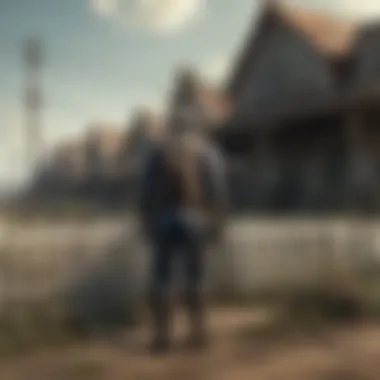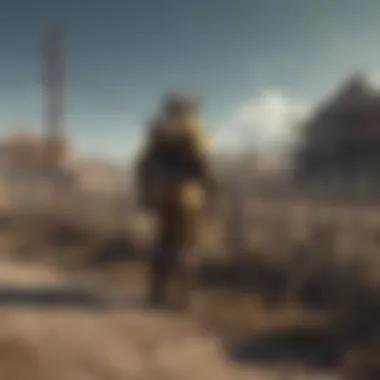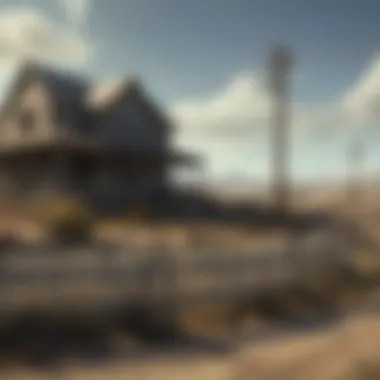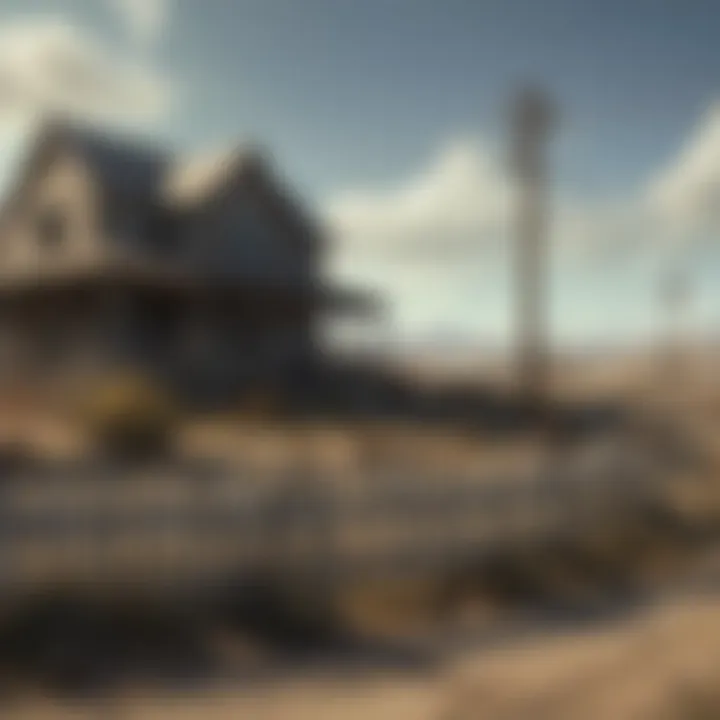The Picket Fence: A Symbol of Nostalgia in Fallout Culture


Intro
The picket fence holds a special place in the Fallout universe. It is more than just a decoration. It is a symbol. As players traverse the remnants of a devastated world, the image of the picket fence represents an ideal—normalcy amidst chaos. This article will explore how the concept of the picket fence is intricately woven into Fallout's storytelling and social commentary.
Lore Insights
The Fallout series exists in a universe ravaged by nuclear war and subsequent societal collapse. The fallout from these catastrophic events has shaped not only the physical landscape but also the cultural paradigms of the game's inhabitants. Understanding the significance of elements like the picket fence provides deeper insight into the fractured world where characters strive to reconstruct their lives.
Overview of the Fallout Universe
Set in an alternate timeline where World War II extends into the 1950s, Fallout introduces players to a world both familiar and hauntingly foreign. The nuclear bomb has erased much of civilization, leaving behind a variety of factions and survivors who either cling to or oppose the pre-war ideals. Here, objects like the picket fence encapsulate media-driven visions of security and happiness.
Key Historical Events in the Fallout Timeline
Several pivotal moments shape the Fallout narrative:
- The Great War of 2077: A brief but disastrous nuclear conflict leads to the end of the world as it was known.
- The rise of vaults: Underground shelters created to protect people, often leading to disastrous social experiments.
- The emergence of factions: Groups such as the Brotherhood of Steel and the Institute further fragment humanity, each with differing ideologies and priorities.
These events highlight the complexities of human behavior under strain, and the quest for societal norms often comes back to symbols like the picket fence.
Deep Dive into the Backstory of Major Factions and Characters
In the Fallout universe, icons like the picket fence often represent different ideologies:
- The Brotherhood of Steel: Believes in technological purity and preservation.
- The Railroad: Focuses on freedom and autonomy, especially for synthetic beings.
- The Wasteland: Various settlements emerge defining what normalcy means in a broken world.
Each faction offers its unique interpretation of what post-apocalyptic life can/should be, making the imagery of picket fences versus wastelands a compelling contrast.
Character Analysis
Analyzing characters within the Fallout universe reveals much about humanity's consensus around ideals wrapped in symbols. Of crucial interest is how characters express their relationship to the concept relied on perceived normality.
Detailed Profiles of Iconic Characters
Characters like The Sole Survivor, from Fallout 4, reflect the desire to return to lost paradises represented by symbols akin to the picket fence. They search for family and community in the vast wasteland, illustrating humanity's longing for connection and safety.
Relationships Between Characters in the Fallout Series
Misunderstandings and connections played out in these character arcs deeply interact with the lore. For instance, the protagonist’s relationship with factions often leads to choice points mirroring the wish for a ‘normal’ society.
Character Development and Evolution Across Games
Character arcs involving betrayal, sacrifice, and ideological conflicts enrich the overall narrative. Here again, the image of the picket fence serves as a reminder of what they fight for, or, more poignantly, what has been lost.
Epilogue
The significance of the picket fence in the Fallout culture cannot be overstated. It is transcendent of mere physical presence. It encapsulates the struggles between ideals and the stark, often unrecognizable shifts in society post-collapse. A Rwanda subplot, harmful meta-commentaries of nostalgia versus reality unfold leading towards reflection on historical human behavior. Rather than purely aesthetic, picket fences articulate folklore and expose societal longings.
By understanding these nuanced significances, players can achieve a richer experience, embarking on journeys that resonate not only with Fallout’s fragmented universe but also with ongoing dialogues in modern culture.
Prelims to the Picket Fence Concept
Understanding the picket fence concept offers insight into both the lore and artistic expression leveraged within the Fallout series. This idea becomes not just a physical manifestation in a game but a profound symbol of what society once valued. Picket fences conjure images of suburban life, security, and norms that have transitioned into nostalgic memories. By unpacking the intricacies of this narrative element, we find connections to broader socio-cultural themes within American society.
Definition and Origins


The term picket fence historically refers to a fence composed of vertical boards, often used in residential properties. The arrangement suggests order and boundary, framing the ideal of home. In popular culture, this structure represents traditional family values and neighborhood camaraderie. The picket fence became prominent in post-World War II America when affluence grew and suburbanization peaked. People began to associate it with success, comfort, and normalcy, ideas that Fallout creating into its narrative fabric.
Cultural Significance in American Society
In the U.S., the picket fence symbolizes not just home, but also shared humanity against the backdrop of upheaval. It signifies various themes prevalent through decades:
- The American Dream: The desire for property ownership, stability, and familial happiness reflects this ideal.
- Nostalgia: Reminiscing a simpler time highlights how past comforts starkly contrast today's chaotic realities looking into the cataclysmic outcomes presented in Fallout.
- Community Dynamics: Fences often legally and physically delineate spaces, reinforcing societal distinction even within small neighborhood clusters. Suburbs constructed during the boom of post-war America nurtured community bonds, which are themes Salt-flat combats both nostalgically and critically within its storytelling.
Through the context of the Fallout series, these themes blend into rich, multifaceted narratives that compel players to reflect on both a lost America and the societal structures we often take for granted.
The Picket Fence in Fallout: An Overview
The role of the picket fence in the Fallout universe extends far beyond mere aesthetic appeal. It serves as a powerful symbol entwined with nostalgia, representation of norms, and a poignant reminder of a lost world. Understanding this significance is crucial for players and fans, as it encapsulates the dualities present in the game. The picket fence denotes a desire for safety and the stabilization of pre-war life amid the stark realities of a post-apocalyptic environment. It invites contemplation over what has been lost and what could possibly be rebuilt.
Visual Aesthetics
In the Fallout series, the visual elements are undeniably striking. The picket fence appears not only in player settlements but throughout much of the game's landscapes. Its classic design indicates homeliness; this imagery contrasts sharply with crumbling buildings and desolation that repeat elsewhere. By integrating these fences into the environment, the games create an atmosphere rich with ambiguity and tension. Here, players are remind of both a simpler time and their current struggles for survival.
The aesthetic application of the picket fence communicates subtle subtext in ways that influence player emotions and actions. As players roam the broken world, encountering scenes displaying picket fences associated with derelict houses, they cannot help but feel a sense of yearning. This visual nostalgia fuels an intrinsic longing that shapes player experiences while enhancing overall storytelling.
Symbol of Pre-War Ideals
More than a decorative element, the picket fence stands as a testament to the values and ideals established in America prior to the event that led to the Fallout universe conditions. It embodies the concepts of family, community, prosperity, and the ideal American dream. Players and characters alike grapple with these ideological elements, cut short by conflict and destruction.
As players traverse towns like Sanctuary Hills or Red Rocket, encounters with picket fences ask them to reflect on pre-war civility versus randomized chaos. A fence indicates boundaries, but in resolutions made on their journey, players frequently challenge these boundaries, both literally and thematically. They deal with remnants of civilization and its implications on their current reality. The picket fence is key when exploring themes of hope and desolation, providing a dual representation that makes each fence far more than a mere wooden barrier.
“In a world governed by brutality, the image of a picket fence occupies a unique position—a reflection of what once was and what might yet again bloom.”
Dealing with this stark contrast sheds light on character motivations, and allows for nuanced deliberation on the values recovered over trauma and upheaval. Players face decisions that challenge or affirm those social ideals, asserting or relinquishing the past along the way.
Narrative Implications of the Picket Fence
The concept of the picket fence in Fallout extends beyond mere decoration. It uncovers deep narrative implications that resonate through various layers of gameplay and story. No longer just a physical barrier, the picket fence stands as a critical element that reflects contrasting ideals and the complexities of character motivations in a fractured world.
At its core, these fences represent a relatively simpler and normal life. In a post-apocalyptic environment where chaos reigns, they symbolize what was once a secure setting. However, this symbol directly contrasts with the harsh realities of the wasteland where survival dominates over nostalgia. Amidst wreckage, the presence of a picket fence invokes thoughts of lost normalcy, functioning as a reminder of what characters might have been stripped of throughout their journeys.
Contrasting Realities
In the broad context of the Fallout series, the picket fence symbolizes two diverging realities. On one side, it suggests the safety and comfort of suburban life, with visuals embedding themselves in the players’ minds. On the other side, these visuals starkly contrast the remnants of dystopian environments filled with danger and struggle. In such spaces, hope battles despair. This duality allows players to sense an acute yearning for the aforementioned life - a form of inner conflict that often drives what characters do throughout their quests.
The juxtaposition between pastoral past and apocalyptic present provides rich narrative tension, propelling both story and character dynamics in Fallout.
Additionally, the picket fence addresses themes intrinsic to the Fallout narrative. It engages players in grappling with ideals of domesticity in open-world settings where perhaps domesticity feels unachievable. By placing the ideal within a chaotic landscape, the narrative hints at underlying questions about loss, dreams, and the nature of humanity amid desolation. The significance lies in how characters react to this dichotomy to survive rather than merely exist.
Character Development and Backstories
The influence of the picket fence transports into character arcs, where its symbolism influences choices and actions. Characters’ backstories may often reveal an attachment to what the picket fence represents. Many hail from havens where life seemed more predictable and safe. This chained narrative structure naturally unveils their struggles to regain such a semblance in varied settings.
Exploring a character like The Sole Survivor from Fallout 4, we see that these backstories deeply react to typical fears and grievances of disrupted family life. The presence of a picket fence likely reminds players of their character’s unsettling past experiences, as well as their grief. Throughout this context, character-driven conflicts arise, influenced by both an inner moral compass and longstanding dreams of re-establishing those precious connections.
In essence, the narrative implications surrounding the picket fence facilitate richer lore while virtually defining characters within their respective choices, conflicts, and growth. The journeys players undertake are not only about questing from place to place but discovering how the scars of fracture can shape an individual identity further.
Gameplay Elements Related to the Picket Fence
The picket fence serves as more than a nostalgic symbol in the Fallout series; it also impacts gameplay mechanics significantly. The integration of this element is essential for immersing players in a post-apocalyptic environment where reconstruction of civilization runs parallel to personal and communal challenges. Here, we delve into the base building mechanics related to the picket fence and how quests promote themes of domesticity.
Base Building Mechanics


In recent iterations of the Fallout franchise, particularly in Fallout 4, players encounter extensive base building mechanics. Here, the picket fence comes to signify the semblance of domesticity in a fractured world. Players can construct fences and similar structures to create boundaries. This element not only provides physical shelter but also psychological security. The process of building allows players to channel their creative instincts, transforming abandoned wastelands into havens.
- Resource Allocation: Players must gather various materials to build fences. This highlights the utility of scavenging, which forms a core part of the gameplay experience.
- Defense Mechanism: Fences sometimes act as defensive structures against incoming threats. Establishing boundaries enhances a settlement’s security, reinforcing a literal and metaphorical sense of safety.
- Community Aspect: The ability to create desirable living spaces attracts other NPCs, enhancing player experiences as settlers contribute to the functionality of the settlement. This reflects a community-centric approach.
The physical representation of the picket fence resonates deeply with players. It becomes a symbol for the effort put into creating a stable life, even amidst chaos.
Quests and Missions Involving Domesticity
Within the narrative arc of Fallout games, quests focused on domestic themes underscore personal connection amidst the desolation. Players often engage in missions that revolve around reclaiming home and rebuilding a sense of normalcy. Through these quests, several important aspects unfold:
- Personal Stakes: Missions tied to domestic life often involve characters seeking to preserve their families or salvage personal items. This heightens emotional engagement and adds layers to the storyline.
- Restoration Goals: Quests encourage players to reclaim land and restore old homes, often with associated lore that reinforces the pitfalls of nuclear warfare. This invites introspection and emphasizes a return to pre-war ideals.
- Environmental Storytelling: Each quest reinforces how the picket fence ties into larger environmental storytelling. By capturing and reviving the living spaces of the past, quests delineate the stark contrast between pre- and post-apocalyptic life, making players keenly aware of the history behind their current survival.
In this sense, missions surrounding domesticity enrich the narrative. They challenge players to confront questions of legacy and the human spirit while aiming to reinstate some semblance of normal life where everything seems lost.
"A settlement is not just a physical location. It is an extension of the player's virtues and immediate desires in a world stripped of certainty."
Overall, gameplay elements related to the picket fence are integral to fostering narrative depth and enhancing player engagement. They lay the groundwork for meaningful experiences within the stimulating landscape of the Fallout universe.
The Picket Fence as a Symbol of Hope
The concept of the picket fence in Fallout serves a more profound purpose than mere decoration or nostalgia; it embodies hope in a desolate world. This symbolism is central to the narratives woven throughout the series. The presence of a picket fence represents the desire for normalcy and safety after a cataclysmic event. Philosopher Albert Camus once stated, "Hope is the option of keeping mentality in the struggle and limiting despair, even within total destruction." The picket fence brings this statement to life within the Fallout universe, signifying what was lost but can potentially be rebuilt.
Reconstruction after Destruction
In the aftermath of a nuclear apocalypse, players encounter a landscape strewn with ruins and chaos. The immediate environment often reflects humanity's worst excesses, reminding players of both loss and a failed civilization. Amid this decay, the picket fence symbolizes the possibility of re-establishing a community and constructing new lives amid the wreckage. It invites characters and players alike to envision not just survival but a return to a life of simplicity and domesticity.
One way this is portrayed in the games is through settlements and bases where players can build spaces that rival the pre-war American dream. Players often find crafting stations that allow them to collect materials and erect picket fences, marking the area they inhabit. This is not just a matter of defense against external threats but an assertion of belonging. It shows a rejection of despair and a commitment to nurturing something worthwhile amidst chaos.
As settlements arise from the rubble, they stand as testaments to human resilience and innovation, suggesting rebirth from the ashes.
Community Building in a Broken World
The picket fence also conveys a communal spirit. In the turbulent environments of Fallout, rebuilding means coming together, shared resources, and collaborative efforts towards a common goal. Settlements allow characters to develop relationships and foster connections. The act of creating or repairing picket fences serves as the foundation for bonding experiences. It creates a sense of identity, establishing narratives of care amongst survivors.
Working together to build homes and communities helps characters rediscover their humanity. Many quests revolve around assisting these efforts, emphasizing how important uniformity and shared spaces are. Such endeavors align perfectly with themes of teamwork found throughout the series. Players often notice that as communities flourish, underlying social structures emerge, which are essential for depicting what hope can look like in a shattered world.
Thus, the picket fence remains not just a leisure feature or nostalgic touch; it is integral to showcasing the drive for reintegration and mutual support in the post-apocalyptic society of Fallout.
Critiques of the Picket Fence Narrative
The concept of the picket fence in Fallout culture offers a complex lens through which to analyze notions of normalcy and hope within a chaotic, post-apocalyptic landscape. While it can symbolize stability, its narrative critiques unveil a dichotomy between idealism and realism. This section examines the specific aspects of those critiques, particularly relevant in an analysis aimed at discerning Fallout's success as more than just a frugal attempt at maintaining aesthetics amid destruction.
Idealism vs.
Realism in Post-Apocalyptic Settings
In Fallout, the picket fence embodies nostalgic idealism—an image of an America that thrives in peaceful suburbia. However, the game's stark realities often contend against this portrayal. The nuclear wasteland, devoid of the warmth of community and safety, illustrates a more brutal existence. This contradiction raises interesting questions. To what extent can these post-apocalyptic visions avoid falling into the trap of mythologizing the past?
In many instances, players feel the constant tension between the erased suburbs and the charred remnants of society. The idealism associated with the picket fence represents a desire for a return to a simpler era—a longing shared by many players seeking comfort in gaming. However, this tension forces them to navigate the discrepancy between wanting this picked memory of home and facing relentless threats that exist outside it. As players build their own scrap fences to protect their settlements, resurfaced themes such as the futility of rebuilding idealism amidst environmental decay manifest themselves in gameplay and tasks.
Deconstruction of American Values
The picket fence resonates particularly with core ideals linked to American values, such as suburban prosperity, security, and family life. Fallout critiques this distorted reflection of society by deconstructing it through storytelling and gameplay. The ugly truths interspersed throughout missions illustrate that the picture-perfect life represented b the picket fence lacks substance.
Being bombarded with post-apocalyptic scenarios that challenge traditional values ensures works like Fallout don’t merely romanticize or nostalgiaize culture. By living within shattered ideals, players may confront the concept of inherent distraction caused by materialism, as seen through various elements of the game. Missions like scavenging broken settlements underscore this message by transfoming picks for the illusion into exposes of desperation.
Moreover, it's vital to condiser that deconstruction isn’t simply about rejecting historical elements. The picket fence serves dual roles; simultaneously denoting hope for victory and survival following devastation, while it also acts as a guide to critical installations that symbolize core flaws within preset structures of thought.


"The inherent critique of suburbia in the Fallout series achieves resonance with a contemporary audience grappling with their ideals of life and existence in an often unforgiving world.”
These layers of critique surrounding the picket fence contribute substantially to a nuanced dialogue about existence and the collective aspirations dwelling within the comfort these symbols represent. Factors shaping and narrating the discussions unite past experiences with wiser observations about progress, architecture, and the ideals we attain to instill through play.
Comparative Analysis with Other Media
The inclusion of picket fences within the Fallout universe serves as an effective lens through which to examine similar themes presented in other media. Observing how other works of art—be it video games, literature, or film—utilize similar imagery can deepen our understanding of the ideals and contradictions surrounding the notion of domesticity and safety after catastrophic events.
Picket Fences in Other Video Games
Various video games have explored the theme of the picket fence as a representation of an elusive security. For instance, titles like The Sims integrate familiar suburban aesthetics and idealized domestic life, which mirrors the appearance of a picket fence. However, the game simultaneously omits the chaos of its past—intentionally focusing on the utopian aspects of society. In Farming Simulator, the players create their own idyllic homesteads, often surrounded by picturesque fences, emphasizing agricultural peace.
Contrastingly, The Last of Us presents picket fences not as a symbol of hope but rather failure. Here, they appear in a world filled with danger, showcasing remnants of a normal life now overshadowed by post-apocalyptic dread. This creates a layered context, reflecting deterioration rather than tranquility. In all, while the imagery may resonate similarly, the game environments shape their significance quite differently.
Depictions in Literature and Film
In literature, the picket fence often carries multilayered significances. For example, in works like American Beauty, the picket fence encapsulates the facade of the perfect suburban life contrasted against the turmoil brewing within its confines. This motif evokes the complexities surrounding the American Dream—what at first appears wholesome masks deeper discontent.
Similarly, in films such as Little House on the Prairie, the fantasy of pastoral life is evident. The presence of picket fences represents stability and family. However, it often glosses over larger struggles faced by characters, reinforcing the tendency of such visuals to underplay larger societal truths.
Consequently, while the picket fence emerges across various media, its role is not static. Each context within video games, literature, and film contributes to an evolving conversation where hope and despair coexist, ultimately informing how we interpret and engage with this ubiquitous symbol within the Fallout series.
Community Perspectives on the Picket Fence
The significance of the picket fence extends beyond its simplistic design; it shapes narratives within the Fallout community. Within this context, player interpretations and theories offer insights into the very heart of the series. Engaging with these perspectives enriches our understanding of the picket fence, representing broader themes in the game's post-apocalyptic world.
Fan Theories and Interpretations
Fans have developed numerous theories around the picket fence, exploring its symbolism in various ways. Some see it as a representation of lost innocence. It evokes a nostalgic image of a pre-war America, contrasting starkly with the unsettling reality of the wasteland. Others link it to the American Dream; the fence offers a sense of belonging and safety amidst chaos.
Additionally, fans on platforms like Reddit often engage in debates and discussions. Many fans argue the presence of the picket fence reveals a longing for simplicity in a complex world. This fascination with domesticity highlights the desire for a return to normalcy, where human connections and community play vital roles. Exploring these theories fosters a deeper dialogue about personal experiences, cultural values, and overarching themes of hope amid hopelessness.
Impact on Fallout Fandom
The picket fence has a lasting effect on the Fallout fandom, inviting diverse interpretations and discussions. It frames a space for players to voice ideas about survival, morality, and human nature. As the fallout community interacts with the game, the picket fence becomes a shared symbol, uniting players in their shared experiences and narratives.
Through cosplays, fan art, and various fanfiction, references to the picket fence can be found widely in community-generated content. These interpretations allow players to express their views on how idealized themes can contrast with lived experiences of loss and destruction.
In summary, the community perspectives on the picket fence evidence its profound influence. This house icon has grown beyond its physical representation to encapsulate enduring ideas, discussions, and interpretations among fans, which underscores its lasting importance in Fallout culture.
The End: The Enduring Legacy of the Picket Fence
The significance of the picket fence in the Fallout series ultimately embodies a complex intersection of nostalgia, idealism, and critiques of American culture. It projects an image of what might have been—a sanctuary of domestic tranquility amidst chaos. This stark imagery is woven deeply within the narrative and its presentation.
As players navigate desolate landscapes and ruined cities, the picket fence stands as a remnant of an age where stability seemed attainable. Yet, it is our lingering impressions of these representations that resonate far beyond superficial aesthetics. The picket fence serves as a conduit for players to engage with their own concepts of home, even while immersed in despair.
Lasting Impressions in the Fallout Universe
The lasting impressions left by the picket fence in Fallout go far beyond its physical appearance. It transports players to the thematic heart of pre-war America, where simplicity and family values reigned supreme. This visual motif quickly pivots to highlight the effects of post-apocalyptic devastation, where the potential for a return to normalcy feels painfully idealistic.
Key aspects of the picket fence's lasting impression include:
- Visual Representation: Scene settings articulate a post-war nostalgia that draws players into a mournful yet reflective state.
- Interactive Engagement: Players build and customize dwellings, incorporating fences to symbolize their personal sanctuary amongst devastation.
- Cultural Context: Fans cite the picket fence as an emblem of civilized life contrasted against their brutal experience in the wasteland.
Thus, its role extends to encapsulating all that Fallout strives to challenge. It evokes a sense of longing and loss while addressing larger social constructs. This duality creates a memorably lasting experience for each player.
Reflections on Hope and Perseverance
Reflections within the Fallout realm often involve the notion of hope and perseverance through trying times. The picket fence acts as a powerful symbol of these concepts. Even against the bleakest backdrops, the fence suggests resilience in rebuilding and the aspiration for a stable existence.
- The picket fence signifies not just a boundary, but a place where families thrived.
- Players seek to overcome challenges and construct their understanding of peace, mirroring a collective desire for rebirth.
- Incorporating this symbol in gameplay elements also emphasizes the player’s role in shaping the future, challenging chaos with personal autonomy.







